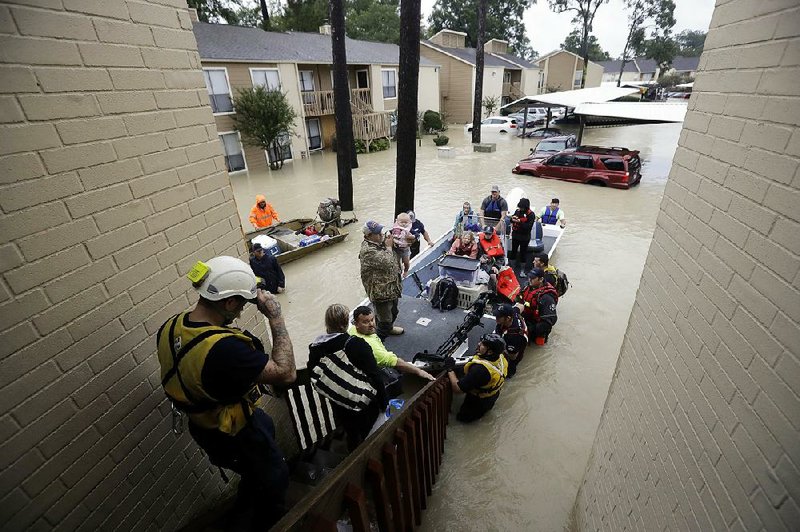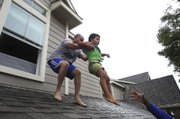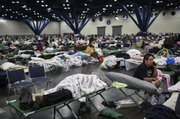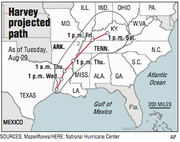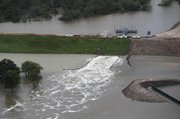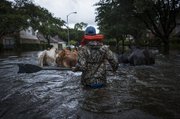HOUSTON -- Houston moved Tuesday to free up more mega shelters as the human toll and the strain on flood defenses mounted and the rain from Harvey officially became the heaviest tropical downpour in U.S. history.
So far, more than 17,000 people have sought refuge in Texas shelters, and that number seemed certain to increase, the American Red Cross said.
"We are not turning anyone away. But it does mean we need to expand our capabilities and our capacity," Mayor Sylvester Turner said at a news conference in which he said the city was looking to open more high-capacity shelters. "Relief is coming."
The city's largest shelter, the George R. Brown Convention Center, held more than 10,000 people by Tuesday evening, twice the number officials originally planned to house there. The crowds included many from areas outside Houston.
On Tuesday night, a spokesman for Turner said the city was opening the convention center at NRG Park, which also is home to the city's NFL stadium and the Astrodome. The new shelter can accommodate up to 10,000 more evacuees, the spokesman said.
In an evening news conference, Turner announced that the Toyota Center, the downtown arena that is home to the Houston Rockets, would be opened to evacuees to help reduce overflow at the convention center. That arena would serve only families with children who don't have pressing medical needs, said Tom McCasland, Houston's housing and community development director.
The city also has asked the Federal Emergency Management Agency for more supplies, including cots and food, to accommodate an additional 10,000 people, said Turner, who hoped to get them no later than today.
In an apparent response to scattered reports of looting, the mayor imposed a curfew. Police Chief Art Acevedo said violators would be questioned, searched and arrested.
[STORM TRACKER: Follow Harvey’s projected path]
Earlier in the day, televangelist Joel Osteen opened his Houston mega church, a 16,000-seat former arena, after critics blasted him on social media for not acting to help families displaced by the storm, and Louisiana's governor offered to take in Harvey victims from Texas.
Gov. John Bel Edwards said he expected Texas officials to decide within 48 hours whether to accept his offer, which comes as Louisiana deals with its own flooding. About 500 people were evacuated from flooded neighborhoods in southwest Louisiana, Edwards said.
Meteorologists said Houston would soon have a chance to dry out.
When Harvey returns to land today, "it's the end of the beginning," National Hurricane Center meteorologist Dennis Feltgen said.
The weather service forecast less than an inch of rain for Houston today, and only a 30 percent chance of showers and thunderstorms for Thursday. Friday's forecast calls for mostly sunny skies with a high near 94.
Harvey will spend much of today dropping rain on Louisiana before moving on to Arkansas, Tennessee and parts of Missouri, which could also see flooding. But, Feltgen cautioned, "We're not done with this. There's still an awful lot of real estate and a lot of people who are going to feel the impacts of the storm."
Four days after the storm ravaged the Texas coastline as a Category 4 hurricane, authorities and family members have reported at least 18 deaths. They include a woman killed when heavy rain sent a large oak tree crashing onto her trailer and another woman who apparently drowned after her vehicle was swept off a bridge.
Houston police on Tuesday confirmed that a 60-year-old officer drowned in his patrol car after he became trapped in high water while driving to work. Sgt. Steve Perez had been with the force for 34 years.
Earlier, six members of a family were feared dead after their van sank into a drainage channel in East Houston. And a Houston hotel said one of its employees disappeared while helping about 100 guests and workers evacuate the building.
The Harris County forensic office reported three other fatalities late Tuesday: an 89-year-old woman, Agnes Stanley, who was found floating in 4 feet of floodwater in a home; a 76-year-old woman who was found floating in floodwater near a vehicle and whose name wasn't released; and a 45-year-old man, Travis Lynn Callihan, who left his vehicle and fell into floodwaters. Callihan was taken to a hospital, where he died Monday.
The bodies of some of the reported victims have not been found.
Authorities acknowledged that fatalities from Harvey could soar once the floodwaters start to recede from one of America's most sprawling metropolitan centers. The Houston metro area covers about 10,000 square miles, an area slightly bigger than New Jersey.
All across Houston on Tuesday, the rescuers and the rescued repeated the same sentiment: This doesn't happen here.
"I've lived here since 1994, and it's never been this high," said Bonnie McKenna, a retired flight attendant living in Kingwood, along the raging San Jacinto River on Houston's northeast side.
The Arkansas National Guard on Tuesday sent two Black Hawk helicopters to Texas to assist in search-and-rescue missions, spokesman Maj. Will Phillips said. Each chopper entails a crew of five -- a pilot, co-pilot, crew chief and two soldiers to operate the "hoist" to airlift stranded storm victims.
The helicopters initially flew to a staging facility near Dallas, but the crews were to spend the rest of Tuesday conducting search-and-rescue operations as weather conditions allowed, Phillips said.
The two helicopter crews followed the Monday deployments of a 14-member survey team from the 61st Civil Support Team and two C-130s.
The survey team plans to test water, soil and air for toxic chemicals once flood waters recede. The C-130 crews transported a special operations recovery team and supplies to Texas, returning to Arkansas late Monday.
Phillips said the Guard is in a "wait and see status" to determine whether additional deployments will be necessary to aid in recovery efforts in south Texas or Louisiana.
Over the dams
Worsening the floodwaters, a pair of 70-year-old reservoir dams that protect downtown Houston and a levee in a suburban subdivision began overflowing Tuesday.
Engineers began releasing water from the Addicks and Barker reservoirs Monday to ease the strain on the dams. But the releases were not enough to relieve the pressure after the relentless downpours, Army Corps of Engineers officials said. Both reservoirs are at record highs.
The release of the water means that more homes and streets will flood, and some homes will be inundated for up to a month, said Jeff Lindner of the Harris County Flood Control District.
Brazoria County authorities posted a message on Twitter warning that the levee at Columbia Lakes south of Houston had been breached and telling people to "GET OUT NOW!!"
Brazoria County Judge Matt Sebesta said residents were warned that the levee would be overtopped at some point, and a mandatory evacuation order was issued Sunday.
The levee was later fortified, but officials said they did not know how long the work would hold.
Officials in Houston were also keeping an eye on infrastructure such as bridges, roads and pipelines that are in the path of the floodwaters.
Water in the Houston Ship Channel, one of the nation's busiest waterways, which serves the Port of Houston and Houston's petrochemical complex, is at levels never seen before, said Jeff Linder of the Harris County Flood Control District.
The San Jacinto River, which empties into the channel, has pipelines and roads and bridges not designed for the current deluge, Linder said, and the chance of infrastructure failures will increase the "longer we keep the water in place."
Among the worries is debris coming down the river and crashing into structures and the possibility that pipelines in the riverbed will be scoured by swift currents.
After five consecutive days of rain, Harvey set a new continental U.S. record for rainfall for a tropical system.
The rains in Cedar Bayou, near Mont Belvieu, Texas, reached 51.88 inches as of 3:30 p.m. That's a record for both Texas and the continental United States, but it does not quite surpass the 52 inches from Tropical Cyclone Hiki in Kauai, Hawaii, in 1950 -- before Hawaii became a state.
The previous record was 48 inches set in 1978 in Medina, Texas, by Tropical Storm Amelia. A weather station southeast of Houston reported 49.32 inches of rain.
John Nielsen-Gammon, the state climatologist, found that Harvey's total rainfall concentrated over a 20,000-square-mile area over 72 hours represents nearly 19 times the daily discharge of the Mississippi River, by far the most of any tropical system ever recorded.
Before it breaks up, Harvey could creep as far east as Mississippi by Thursday, meaning New Orleans, where Hurricane Katrina unleashed its full wrath in 2005, is in Harvey's path. Foreboding images of Harvey lit up weather radar screens on the 12th anniversary of the day Katrina made landfall in Plaquemines Parish.
Information for this article was contributed by Nomaan Merchant, Juan Lozano, Frank Bajak, Michael Graczyk, Diana Heidgerd, David Warren, Seth Borenstein and Tammy Webber of The Associated Press; by Kevin Sullivan, Arelis R. Hernandez, David A. Fahrenthold, Emily Wax-Thibodeaux, Alex Horton, Dylan Baddour, Brittney Martin, Mark Berman, Steven Mufson, Ed O'Keefe, Wesley Lowery, Thomas Gibbons-Neff, Katie Zezima, Jason Samenow, Ashley Cusick, Mary Lee Grant and Jason Samenow of The Washington Post; and by Hunter Field of the Arkansas Democrat-Gazette.
RELATED ARTICLES
http://www.arkansas…">In Texas, Trump urges best ever disaster efforthttp://www.arkansas…">Deluged homes' owners on hook
A Section on 08/30/2017
